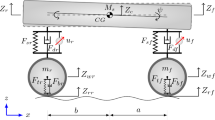Abstract
In order to improve ride comfort and handling performance of the vehicle, an adaptive hybrid control algorithm is proposed for semi-active suspension systems. The virtues of sky-hook is combined with ground-hook control strategies and a more suitable compromise for the suspension systems is chosen. The hybrid coefficient is tuned according to the longitudinal and lateral acceleration so as to improve the vehicle stability especially in high speed conditions. Damping continuous adjustable absorber is used to continuously control the damping force so as to eliminate the damping force jerk instead of traditional on-off control policy. Based on suspension stroke measured by sensors, unscented Kalman filter is designed to estimate the suspension states in real-time for the realization of hybrid control, which improves the robustness of the control strategy and is adaptive to different types of road profiles. Finally, the proposed control algorithm is validated under the following two typical road profiles: half-sine speed bump road and the random road. The simulation results indicate that the hybrid control algorithm could offer a good coordination between ride comfort and handling of the vehicle.
Similar content being viewed by others
References
KOCH G, KLOIBER T. Driving state adaptive control of an active vehicle suspension system [J]. IEEE Transactions on Control Systems Technology, 2014, 22(1): 44–57.
AHMADIAN M E H D I, DAVID E, SIMON. An analytical and experimental evaluation of magneto rheological suspensions for heavy trucks [J]. Vehicle System Dynamics, 2003, 37(S): 38–49.
PARE C A. Experimental evaluation of semiactive magneto-rheological suspensions for passenger vehicles[D]. Blacksburg: Virginia Polytechnic Institute and State University, 1998.
LAJQI S, STANISLAV P. Designs and optimizations of active and semi-active non-linear suspension systems for a terrain vehicle [J]. Strojniški Vestnik-Journal of Mechanical Engineering, 2012, 58(12): 732–743.
HEO S J, PARK K, SON S H. Modelling of continuously variable damper for design of semi-active suspension systems [J]. International Journal of Vehicle Design, 2003, 31(1): 41–57.
REN H, CHEN S, FENG Z, LIU G. Study on fuzzy control based on magneto-rheological semi-active suspension [C]// Proceedings of the Third International Conference on Mechanic Automation and Control Engineering. Now York: IEEE Computer Society, 2012: 3539–3542.
CHEN Y, WANG Z, QIU J, HUANG H. Hybrid fuzzy skyhook surface control using multi-objective microgenetic algorithm for semi-active vehicle suspension system ride comfort stability analysis [J]. Journal of Dynamic Systems, Measurement, and Control, 2012, 134(4): 1–13.
KASHEM, S B A, MEHRAN E, ROMESH N. Comparison between different sets of suspension parameters and introduction of new modified skyhook control strategy incorporating varying road condition [J]. Vehicle System Dynamics, 2012, 50(7): 1173–1190.
KARNOPP D, CROSBY M J, HARWOOD R A. Vibration control using semi-active force generators [J]. Journal of Manufacturing Science and Engineering, 1974, 96(2): 619–626.
CHIANG H, LEE L. Optimized virtual model reference control for ride and handling performance-oriented semi-active suspension systems [J]. IEEE Transactions on Vehicular Technology, 2015, 64(5): 1679–1690.
HONG K S, SOHN H C, HEDRICK J K. Modified skyhook control of semi-active suspensions: A new model, gain scheduling and hardware-in-the-loop tuning [J]. Journal of Dynamic Systems, Measurement, and Control, 2002, 124(1): 158–167.
ASSADSANGABI B, EGHTESAD M, DANESHMAND F. Hybrid sliding mode control of semi-active suspension systems [J]. Smart Materials and Structures, 2009, 18(12): 125027.
YAO Jia-ling, SAIED T, TIAN Song-mei, ZHANG Zhong-nan, SHEN Liang. A novel semi-active suspension design based on decoupling skyhook control [J]. Journal of Vibroengineering, 2014, 16(3): 1318–1325.
SONG X, AHMADIAN M, SOUTHWARD S. An adaptive semiactive control algorithm for magnetorheological suspension systems [J]. Journal of Vibration and Acoustics, 2005, 127(5): 493–502.
MORADI M, AFEF F. Adaptive PID-sliding mode fault tolerant control approach for vehicle suspension systems subject to actuator faults [J]. IEEE Transactions on Vehicular Technology, 2014, 63(3): 1041–1054.
GUO D L, HU H Y, YI J Q. Neural network control for a semi-active vehicle suspension with a magnetorheological damper [J]. Journal of Vibration and Control, 2004, 10(3): 461–471.
SUN Lu, CAI Xi-ming, YANG Jun. Genetic algorithm-based optimum vehicle suspension design using minimum dynamic pavement load as a design criterion [J]. Journal of Sound and Vibration, 2007, 301(1): 18–27.
REICHERT B A. Application of magnetorheological dampers for vehicle seat suspensions [D]. Blacksburg: Virginia Polytechnic Institute and State University, 1997.
AHMADIAN M, SONG X, SOUTHWARD S C. No-jerk skyhook control methods for semiactive suspensions [J]. Journal of Vibration and Acoustics, 2004, 126(4): 580–584.
NORGAARD, M, NIELS K, POULSEN, OLE R. New developments in state estimation for nonlinear systems [J]. Automatic, 2000, 36(11): 1627–1638.
REN Hong-bin, CHEN Si-zhong, SHIM T. Effective assessment of tyre–road friction coefficient using a hybrid estimator [J]. Vehicle System Dynamics, 2014, 52(8): 1047–1065.
JULIER S J, UHLMANN J K. Unscented filtering and nonlinear estimation [J]. Proceedings of the IEEE, 2004, 92(3): 401–422.
CHEN B C, SHIU Y H, HSIEH F C. Sliding-mode control for semi-active suspension with actuator dynamics [J]. Vehicle System Dynamics, 2011, 49(1–2): 277–290.
WU Zhi-cheng, CHEN Si-zhong, YANG Lin, ZHANG Bin. Model of road roughness in time domain based on rational function [J]. Transaction of Beijing Institute of Technology, 2009, 29(9): 795–798. (in Chinese)
Author information
Authors and Affiliations
Corresponding author
Additional information
Foundation item: Projects (51375046, 51205021) supported by the National Natural Science Foundation of China
Rights and permissions
About this article
Cite this article
Ren, Hb., Chen, Sz., Zhao, Yz. et al. Observer-based hybrid control algorithm for semi-active suspension systems. J. Cent. South Univ. 23, 2268–2275 (2016). https://doi.org/10.1007/s11771-016-3284-9
Received:
Accepted:
Published:
Issue Date:
DOI: https://doi.org/10.1007/s11771-016-3284-9




